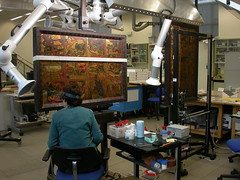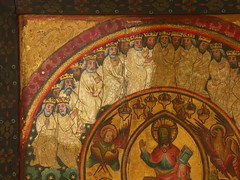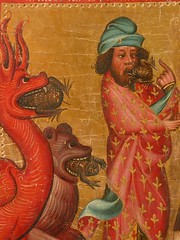By Stuart Frost
 Since February 2008 one of the most enigmatic objects in the V&A’s collections, and one of the earliest acquisitions, has been the focus of a remarkable programme of conservation work. The object, a larger central panel with two hinged wings, is an altarpiece. The panels were made and painted in northern Germany around 1400.
Since February 2008 one of the most enigmatic objects in the V&A’s collections, and one of the earliest acquisitions, has been the focus of a remarkable programme of conservation work. The object, a larger central panel with two hinged wings, is an altarpiece. The panels were made and painted in northern Germany around 1400.
The photograph to the right shows the altarpiece in the paintings conservation studio at the V&A. The wings have been detached to facilitate conservation work.
The painting on the front of the altarpiece consists of forty-five scenes illustrating most of the chapters of the Book of Revelation, the last book in the Bible that describes events at the end of the world. The scenes from the last five chapters are missing which suggests the altarpiece is no longer complete. Most of the scenes are accompanied by text taken from the work of a friar who in the mid-13th century attempted to explain the events of the Book of Revelation in historical terms.
The altarpiece will be included in the new Medieval and Renaissance galleries. In preparation for this the painting was the subject of a technical examination and assessment by conservators Lara Wilson, Rachel Turnbull and Nicola Costaras. X-rays, for example, revealed the extent of later over-painting as well revealing clearly the structure of the wooden panels. Tests were carried out to establish the age of the restoration (probably 19th century) and to assess the condition of the original painting beneath the later layers of dirt and varnish.
Conservators and curators discussed different options for conservation work, assessed the consequences of each and then agreed the final programme of work. What conservation work did the object require and how could the object be displayed to best effect? Some of the paint had become loose and needed to be consolidated. The dirt that had accumulated over time and the varnish had both muted the original colours so it was agreed that both would be removed.
The vast majority of the painting is original but some areas where paint has been lost had been restored. The team at the V&A have decided to remove the areas where restorers had painted over losses with their own speculative compositions. Although work is still in progress it is clear that triptych will be transformed by the conservation work. The pictures that I’ve reproduced here show how vivid the colours are once the surface is cleaned. 
The close inspection of the painting as work has progressed has provided new insights and raised other avenues for research. The question of the attribution, for example, is being assessed again. The quality of the painting revealed by the recent work suggests that the altarpiece was made in the workshop of Master Bertram and that it should be added to the number of other surving paintings associated with this artist. A number of articles exploring different aspects of the triptych will be published in due course and I will post-updates here. If you’d like to know more please post questions below and I’ll do my best to provide answers.
Thanks to Nicola Costaras and Rachel Turnbull for providing the information and pictures for this blog entry. I’ve posted additional images on the Medieval and Renaissance V&A site on Flickr. Click on each of the images here to find out more.